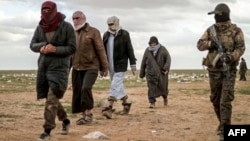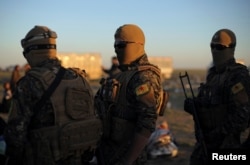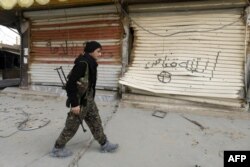The assault on the last patch of land claimed by the Islamic State terror group's caliphate in Syria slowed as it entered its third full day, with U.S.-backed forces announcing a delay due to the presence of additional civilians, many of whom were being used as human shields.
"We're slowing down the offensive in #Baghouz due to a small number of civilians held as human shields by Daesh," Mustafa Bali, a spokesman for the Syrian Democratic Forces, announced on Twitter later Sunday.
Bali did not say what was being done to get the civilians out of Baghuz and out of harm's way, though he warned the reprieve from the fighting would not last long.
"We assert that the battle to retake the last ISIS holdout is going to be over soon," he wrote, using an acronym for the terror group.
Coalition officials first raised concerns about the presence of civilians earlier in the day, noting the vicious nature of the fighting.
"The coalition believes ISIS is still using innocent civilians as human shields, and clearly violating the laws of war," coalition spokesman Col. Sean Ryan said.
The IS tactic of using human shields is not a new one. But it contradicts assertions by some SDF officials, who had said the final assault would not begin until all civilians had been evacuated from the IS-held enclave.
More than an estimated 13,000 civilians evacuated Baghuz in the week preceding Friday's attack by the SDF. According to the United Nations, as many as 90 percent of them were women and children under the age of 5, many of them malnourished.
Sources close to SDF leadership told VOA that as late as Thursday some of those fleeing Baghuz had claimed hundreds of additional civilians were still in hiding. But SDF officials suspected almost all of those left in Baghuz were fighters waiting to make their last stand.
"There aren't any civilians left in Baghuz, so it's a matter of time before we take a full control of it," SDF spokeswoman Lilwa Abdullah told VOA late Friday, describing the initial fighting as intense.
Video shared on social media Sunday by groups with ties to the SDF showed multiple fires burning across the sliver of IS-held land in northeast Syria, while black smoke billowed into the sky.
SDF officials said IS fighters were trying to fend off their advance with car bombs and counterattacks.
"Several car bombs were destroyed by coalition airstrikes during the last two days of battle here in #Baghouz," Bali wrote during an update on Twitter earlier Sunday. "3 VBIEDS [vehicle-borne improvised explosive devices] that were trying to hit our positions were destroyed by #SDF fighters."
Some 15,000 U.S.-backed forces in Syria launched their final assault on IS late Friday, supported by U.S. and coalition warplanes and artillery. On Saturday, SDF officials expressed hope the battle would be over quickly, despite intense firefights coupled with waves of IS suicide bombers.
But progress has been slow, with IS fighters making extensive use of caves and tunnels extending far beneath the village, both for counterattacks and as deathtraps for advancing coalition forces.
"The depth of the tunnels is unknown, other than they are extensive and being filled with IEDs as the SDF closes in," the coalition's Ryan told VOA.
Prior to the start of the battle, sources close to SDF officials on the ground said there was grave concern that an unknown number of IS fighters were hiding below ground, far more than the initial estimates of 300 of the terror group's most hardened and capable fighters. Some warned the tunnel system could extend for more than 2 kilometers.
Monitors with the London-based Syrian Observatory for Human Rights alleged Saturday that the SDF and coalition may have tried to flush out some of the IS fighters by using munitions loaded with white phosphorous when the assault began late Friday.
White phosphorous, which can be used as a smokescreen to cover troop movements or to help trace the trajectory of enemy fire, burns when exposed to air and can be used as an incendiary weapon. Its use is banned in the presence of civilians.
The U.S. is alleged to have used white phosphorous to support forces battling IS in eastern Raqqa in 2017 a charge the U.S. officials at the time neither confirmed nor denied.
But the U.S.-led coalition rejected the accusation white phosphorous is being used in Baghuz.
"Any suggestion of the use of white phosphorus is false," a coalition spokesman told VOA.
Sirwan Kajjo in Washington contributed to this report.












